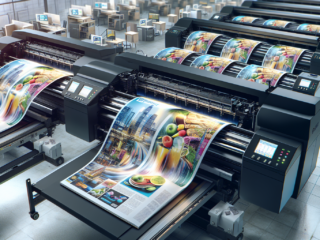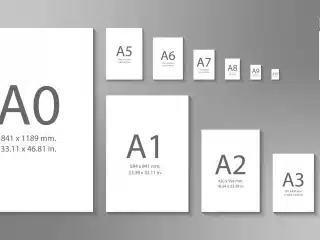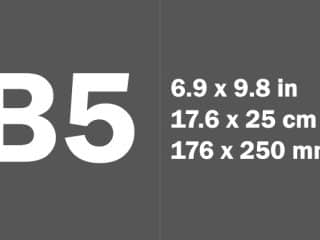In this post, we’ll cover all you need to know about A4 size paper and provide insights on when to use each for your printing needs. Whether you’re drafting a resume, designing a brochure, or preparing documents for international clients, a solid grasp of A4 paper dimensions and applications will enhance the professionalism and compatibility of your work.
Did you know that A4 size paper, measuring 210 x 297 mm ( 8.3 inches by 11.7 inches), is the most widely used paper size globally, especially outside North America? While Letter size (8.5 x 11 inches) is prevalent in the United States and Canada, A4 serves as the international standard for a multitude of documents, from business reports to creative projects. Understanding the distinctions between these paper sizes is crucial for professionals and creatives who operate across different regions.
A4 Paper Size
The first thing to note is that the default printer paper size is not identical to the A4 paper size. They are, however, very close.
Default print jobs are formatted to fit an 8.5-inch by 11-inch piece of paper. Depending on what type of document you’re printing and what program you’re using to print it, it may be labeled “Letter.” A4 size paper, on the other hand, is closer to 8.25-inches by 11.75-inches (but most designers use 8.3 inches by 11.7 inches as their go-to size).
This slight difference stems from cultural differences. Specifically, it reflects the difference between countries that use the metric system and countries that use the imperial system. In the United States and other countries that use the imperial system of measurement, our machines are designed to measure print jobs in inches.
In most of Europe, Asia, and Australia, however, people and machines alike tend to measure print jobs in centimeters. Using metric measurements, the A4 paper size is a more exact 21cm by 29cm.
The printing industry uses the metric system of paper sizes for a couple of reasons.
One, it’s more accessible internationally. The International Organization for Standardization (ISO) designed the A-system of paper measurement with this goal in mind. Even in the United States, Letter paper is a comparable size to A4 paper.
Two, metric paper sizes are intuitive and proportionate. As you increase from A4 all the way up to A1 on the scale, the paper doubles in size.
For example, A3 paper is 29cm by 42cm. The longest side of the A4 paper, which is also 29cm, becomes the shortest side of the A3 paper. Likewise, A2 paper is 42cm by 59.5cm.
Moving down the size chart from A4 to A7, the paper cuts itself in half. For example, the short side of the A4 paper (21cm) becomes the long side of A5 paper.

Need something printed fast?
We do almost everything! From professional reports and brochures to impactful marketing materials, our top-shelf services will get the job done right.
Make a lasting impression with Catdi! Ask for a quote today.
Which Documents Are Best Suited to A4 Paper?
A4 paper is the international standard for a reason—its size and proportions make it incredibly versatile for a wide range of everyday and professional documents. Thanks to its slightly taller and narrower dimensions compared to U.S. Letter size, A4 is ideal for content that benefits from a cleaner, more elongated layout.
Some of the most common documents printed on A4 paper include:
-
Resumes and Cover Letters: In countries that follow ISO standards, A4 is the default for professional job application materials.
-
Academic Papers and Reports: From school assignments to university research, A4 is the standard format for written academic work.
-
Official Forms and Contracts: A4’s clean dimensions allow for more streamlined formatting, especially when including tables, signatures, or multiple sections.
-
Business Letters and Memos: A4 is widely used in offices across Europe, Australia, and Asia for internal and external communications.
-
Manuals and Instruction Booklets: The size makes A4 convenient for printing detailed documents with images or diagrams.
Because A4 is used globally, it’s often the go-to choice for any document that needs to be shared internationally or printed abroad. If you’re working with international clients, suppliers, or collaborators, choosing A4 can help avoid formatting issues down the line.
If you plan on scanning your document to another person or machine, A4 size is your best bet and you’re pretty much guaranteed that the recipient will be able to handle that paper size.
The same is true for physical mailing. Large envelopes are designed to comfortably fit A4 paper without folding or creasing. Likewise, regular envelopes are designed to fit a tri-folded page of A4 paper.
Tips for digital creators and designers: it’s also helpful to know the A4 paper size in pixels when working at 300 DPI: 2480 × 3508 pixels, making it easy to prepare print-ready PDFs or templates that will look polished on any printer using the metric standard.
A4 Size Paper: Full Specs For Print and Digital Projects
Whether you’re designing for print or preparing documents digitally, having precise A4 paper dimensions across various units is essential. Below is a quick-reference table covering all the key measurements you’ll need when working with A4 paper.
A4 Paper Dimensions
Certainly! Here’s a table summarizing the dimensions of A4 paper across various units and resolutions:
| Measurement Unit | Width | Height |
|---|---|---|
| Millimeters | 210 mm | 297 mm |
| Centimeters | 21.0 cm | 29.7 cm |
| Inches | 8.3 inches | 11.7 inches |
| Pixels at 72 DPI | 595 pixels | 842 pixels |
| Pixels at 96 DPI | 794 pixels | 1123 pixels |
| Pixels at 150 DPI | 1240 pixels | 1754 pixels |
| Pixels at 300 DPI | 2480 pixels | 3508 pixels |
| Pixels at 600 DPI | 4960 pixels | 7016 pixels |
Note: DPI stands for Dots Per Inch, indicating the resolution for digital and print formats.
This table provides a clear overview of A4 paper dimensions, facilitating accurate design and printing processes.

Quick Tips for Designers:
- For professional-quality print, always use 300 DPI resolution (2480 × 3508 pixels).
- Use 72 DPI only for screen-based applications where file size needs to stay low.
- Bleed and margin settings: When designing for print, add at least 3mm (0.125 in) bleed on all sides to avoid content getting trimmed.
- For templates or PDF exports, ensure your software is set to A4 (210 × 297 mm) to maintain proper formatting across devices and printers.
IMPORTANT: While these are standardized measurements, we advised you consult with your printing service provider before sending through your document as some printing companies have different bleed and trim requirements.
Illustration of A4 size paper specs

Other Paper Sizes and Printers
Just because A4 paper is the most common paper size doesn’t mean that it is appropriate for every situation.
The international printer standard addresses most of the paper sizes you’ll need for day-to-day business purposes. A7, which is about 3-inches by 4-inches, is perfect for business cards. A6, which is about 4.1-inches by 5.8-inches, is ideal for postcards and notes. If you need something a little bigger, like a menu or a pamphlet, go up to A5 (about 5.8-inches by 8.3-inches).
On the other end of the spectrum, it’s possible that you’ll need to print something on Legal paper, which is 8.5-inches by 14-inches. The width of the short side of Legal paper is the same as that for Letter paper, but it’s a bit longer. This makes it impossible to print on a standard A4 printer.
If you’re working with maps, large flowcharts, or other diagrams, you may need something even larger. Depending on how detailed you want your print job to appear, you can go all the way up to A1.
For smaller print jobs, simply print on smaller paper size. This doesn’t necessarily mean you have to buy smaller paper, just that you’ll need to reconfigure your printer’s settings. (If you’re a PC user, here’s a quick walkthrough of how to change your print settings manually.)
For Legal printing, you should invest in an A3 printer. For anything larger than that, you may need to hire a third-party. Printing companies are equipped to handle larger printer jobs, and you can customize your order to meet your pricing limitations.
Why A4 Remains Relevant in a Digital World
Despite the rise of digitalization, A4 paper remains indispensable in many industries. The education sector still relies on it for assignments, exam papers, and research materials. In government and legal environments, physical documentation continues to play a vital role, and A4 serves as the standard for contracts, forms, and case files. Corporate offices use A4 daily for reports, presentations, and marketing materials.
Even creatives have embraced A4. It’s a go-to format for graphic designers crafting brochures and flyers, as well as artists working on sketches, scrapbooks, and printable templates.
Emerging Trends in A4 Paper Usage
The global shift toward sustainability has had a major impact on paper consumption. There’s a growing preference for eco-friendly A4 paper, especially those made from recycled or responsibly sourced materials. Businesses are increasingly conscious of their carbon footprint and see sustainable paper choices as a small but meaningful step toward greener practices.
From a technology perspective, modern high-speed inkjet and laser printers are designed to work seamlessly with A4 dimensions. These printers, found in both offices and commercial printing setups, enhance productivity and reduce paper waste with features like duplex printing and low-energy consumption.
All Your Printing Needs Addressed in One Convenient Location
Printing from your home isn’t always the best option.
Whether you need standard A4 printing, a print job the size of a stamp, or a banner that can cover the side of a building, it may be better to use a professional printing service.
To check out the possibilities, visit Catdi.com or message a representative through the contact page.
















